If your website were a shop on a busy street in Nairobi CBD at 5:30 p.m., would anyone walk in?
Be honest.
Most business sites look like a locked door with a tiny sign that says “We’re somewhere around here.” Meanwhile, you’re grinding on social—posting reels, quotes, carousels—hoping the algorithm remembers you exist.
Here’s the truth: social is the street, your website is the store. If the store isn’t ready to sell, more foot traffic just means more people walking past.
This post shows you the loop that fixes that: Web Design → Social Content → Measurable Action → Iterate. Once it spins, your brand stops feeling invisible and starts feeling inevitable.
Part 1: Make the Store Worth Entering (Fast Fixes That Don’t Require a PhD)
You don’t need 47 plugins and a committee meeting. You need a few brave decisions.
1) Say one thing clearly, above the fold
Pick one problem you solve and one promise you make. Put it in a big, simple headline with a single button.
-
Finance firm: “Get audit-ready, stress-free—Book a 15-min consult.”
-
School: “Admissions now open—Tour the campus.”
-
Clinic: “Same-day appointments—Call now.”
2) Remove the maze
Your navigation shouldn’t be a puzzle. Keep it to 5–6 items max. If a visitor needs a map, you’ve already lost them.
3) Trust isn’t a paragraph—it’s proof
Swap vague claims for real signals: client logos, 3 short testimonials, 1 concrete outcome, and obvious contact info. Humans buy from humans.
4) Make mobile your default
Look at your site on your phone as if you’re late for a meeting. Can you read the headline? Tap the CTA? Find contact info? If not, fix it.
5) Speed is a feature
Compress images, kill the sliders, ditch auto-play. “It looks fancy” is not the same as “it sells.”
Quick self-check:
Can someone understand what you do in 5 seconds?
Is there exactly one obvious next step on the page?
Can a stranger trust you without Googling your name?
If you nailed this, congrats. You’ve unlocked the door and flipped the “Open” sign.
Part 2: Turn Social Into a Conveyor Belt (Not a Casino)
Random posts are slot machines. A content system is a conveyor belt.
Anchor content once a week (a short blog, case study, or tip sheet), then slice it:
-
LinkedIn: 1 insight + a mini story (authority).
-
Instagram/TikTok/Shorts: 30–45s video showing process, before/after, or a quick tip (reach).
-
Facebook: A friendly summary + CTA (community).
-
X (Twitter): One strong idea in 2–3 lines (spark).
-
Email: “In case you missed it” with one link (return traffic).
Think “Hollywood trailer”: show the best 10–20 seconds of value and direct people to the feature film (your website). Every post should create motion toward one page and one CTA.
Part 3: Mini Wins From Your World (True-to-life, zero fluff)
-
Accounting/Legal: Added a “Book a 15-min consult” button + 3 FAQs to the homepage. Inquiries went up because people finally knew what to click and what they’d get.
-
School/Education: Simplified the admissions page (timeline, fees, tour button). Families stopped DM’ing random questions and started booking visits.
-
Retail/eCom: Replaced studio-only product photos with a 20-sec “in-hand” video and a single benefit-driven headline. Fewer carts abandoned.
-
Real Estate: One property page with map, gallery, 3 bullet benefits, and “Schedule a viewing.” Calls came in from people who were actually ready.
-
Healthcare/Therapy: Put call/WhatsApp buttons above the fold and clarified first-visit steps. Less anxiety = more bookings.
-
OJS/Scholarly: Clean “Submit” page with eligibility checklist, word count, and turnaround expectation. More complete submissions, fewer back-and-forth emails.
Different industries, same pattern: clarity → trust → action.
Part 4: The Weekly Operating Rhythm (WOR) That Compounds
Monday – Make
Publish one anchor piece: “5 fixes for [your industry] websites that actually move the needle.”
Tuesday – Multiply
Turn it into:
-
LinkedIn post (insight + story)
-
IG carousel (screenshots before/after)
-
30–45s Short (talk straight to camera; keep it human)
Wednesday – Proof
Share a micro case study: what changed, how long it took, the one metric that moved.
Thursday – Teach
Answer a real question from your DMs/comments. Keep it simple, no jargon.
Friday – Personal
Founder POV or client shout-out. People follow people.
This rhythm beats “post when inspired.” Consistency builds attention; attention compounds into trust.
Part 5: Track Three Numbers, Not Thirty
Dashboards are great, but decisions love simplicity. Watch:
-
Website clicks to your primary CTA (button taps, calls, form starts)
-
Leads generated this week (not just “likes”)
-
Conversations started (calls, meetings, trials)
If a post doesn’t move one of these, it’s not a failure—it’s a signal. Change the hook, the visual, or the CTA. Keep iterating.
A 7-Day Challenge (Steal This)
Day 1: Rewrite your homepage headline + one CTA.
Day 2: Add 3 proof points (logos/testimonials/outcome).
Day 3: Make the “Contact/Call/WhatsApp” path obvious on mobile.
Day 4: Publish a 400–600 word anchor post (pick one audience).
Day 5: Record a 40-second tip as a Short/Reel/TikTok.
Day 6: Post a before/after (design, copy, structure).
Day 7: Review the three numbers. Decide the one thing you’ll double down on next week.
You don’t need luck. You need a loop.
Want Help Spinning the Loop Faster?
Mamba builds websites that sell and content systems that don’t burn you out.
Grab a free 15-minute mini-audit—one page, one CTA, one week of fixes you can ship immediately.
→ Book your audit here
![Web Design Agency [Top-Rated Company]](https://www.mambatechnologies.com/wp-content/uploads/2025/03/cropped-Untitled_design__6_-removebg-preview.png)




